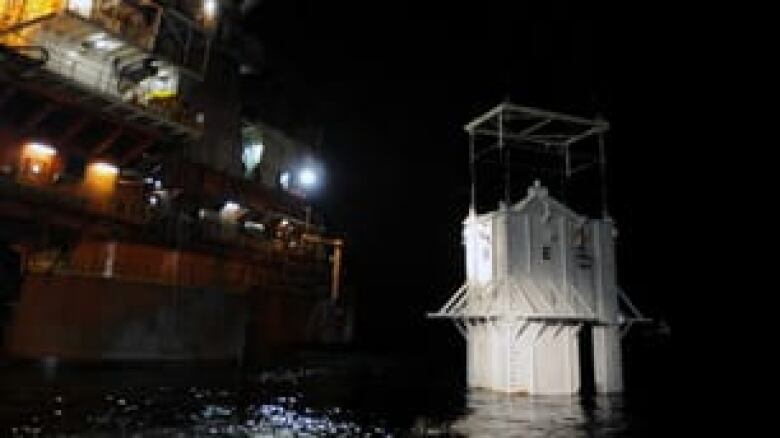Dome lowered over Gulf oil leak
Oil washes ashore in Louisiana wildlife refuge

A containment box weighing about 90 tonnes was placed over a blown-out well that has been spewing oil into the Gulf of Mexico, and has begun settling into the mud, a BP executive said Friday afternoon.
BP spokesman Bill Salvin saidit might take as many as 12 hours for the containment box to settle in place but everything appears to be going as planned.
Crews began lowering the12-metre-tall box by cable 1,500 metres underwater late Thursday.

Securing the box over the leaking pipe so far below the water's surface will take the robots hours and require a feat of precision not previously seen. Robots are the only option because the water pressure that far below the surface is enough to crush a typical submarine.
Earlier, BP chief operating officer Doug Suttles said the robots will be used over the weekend to connect the cofferdam to a drill ship on the surface, with the aim to begin taking oil to the surface early next week.
Suttles also tried to manage expectations about the outcome of the operation.
"We should recognize it has not been done before and we should expect it will undoubtedly have some complications, but we are committed to trying to make this work," he said.
Health issues
As if environmental and economic concerns weren't bad enough, research shows that if it washes ashore the Gulf of Mexico oil spill could cause a long list of potential health hazards, from runny nose and burning eyes to nausea.
Public health agencies are monitoring air quality, drinking water supplies and seafood processing plants and advising people to take precautions.
The U.S. Environmental Protection Agency has began round-the-clock air monitoring in Gulf coastal areas and posting online hourly readings for ozone and tiny particles such as soot.
Both can cause respiratory problems and are particularly aggravating for people with chronic conditions such as asthma.
The Associated Press
BP spokesman Bill Salvin has earlier equated the operation with "taking a four-storey building and lowering it 5,000 feet (1,500 metres) and setting it on the head of a pin,".
The cofferdam is designed to trap the oil gushing out of one of two leaks from the undersea well and suck it up like a vacuum to a tanker on the water's surface.
The structure, which looks something like a milk carton,is seven metresby four metresin widthand 12 metres tall, with a dome-like roof inside it.
Oil giant BP, which is in charge of the cleanup, hopes it will collect as much as 85 per cent of the almost 800,000 litres of crude that have been gushing out of the well daily for the last two weeks.
The leak is one of three that opened after the Deepwater Horizon oil rig leased by the multinational petroleum company exploded April 20, killing 11 people. The rig sank two days later 80 kilometres off the coast of Louisiana.
Crews waited hours before they began lowering the cofferdam, fearing thatwith the dangerous fumes rising from the oily water, a spark caused by the scrape of metal on metal could start a fire.
On Friday, aseparate mission was close to getting underway to spray water around the rig and reduce the level of fumes.
Oil touches shore
Oil from the leak reached the shores of several barrier islands off the coast of Louisiana on Thursday, U.S., state and BP officials confirmed.

Traces of oily sheen had been reported in Louisiana's coastal wetlands since April 29. Thisis the first confirmation by government officials that oil had washed ashore.
As of Friday, BP had laid more than 240,000 metres of boom in the hopes of containing oil on the water's surface before it floats to shore. But high winds and choppy waves rendered the boom almost ineffectual earlier this week.
BP has also conducted controlled burns of parts of the oil slick on open water, and deployed more than a million litres of chemical dispersants meant to break up the oil.
On Friday, the U.S. National Oceanic and Atmospheric Administration (NOAA) expanded the area in the Gulf that is closed to fishingbecause ofthe oil spill. The restricted area runs from the Southwest Pass of the Mississippi River to south of Pensacola, Fla.
NOAA said the restricted area hasbeenenlarged by about 50 per cent, yet still covers only about 4.5 per cent of the Gulf.
Several birds were spotted diving into the oily, pinkish-brown water, and dead jellyfish washed up on the islands.
The islands are part of the Breton National Wildlife Refuge, a nationally protected wilderness area.The protected areais afrequent home to 23 species of seabirds and shorebirds and a nesting place for 13 species, including brown pelicans, laughing gulls and sandwich terns, according to the U.S. Fish and Wildlife Service.
At the southernmost tip of the islands is Freemason Island, a long, barren stretch of sand held together by sea grass and shrubs. Paul Leblanc, who runs a fishing camp, first discovered the sludge-like substance there.
"It's horrible," Leblanc told CBC News as he approached the island in his boat Thursday. "This is what my livelihood depends on fishing around these islands."
"I'm petrified," fellow camp owner Mark Stebley said. "This could ruin my entire way of life."
With files from The Associated Press












_(720p).jpg)


 OFFICIAL HD MUSIC VIDEO.jpg)
.jpg)



























































































